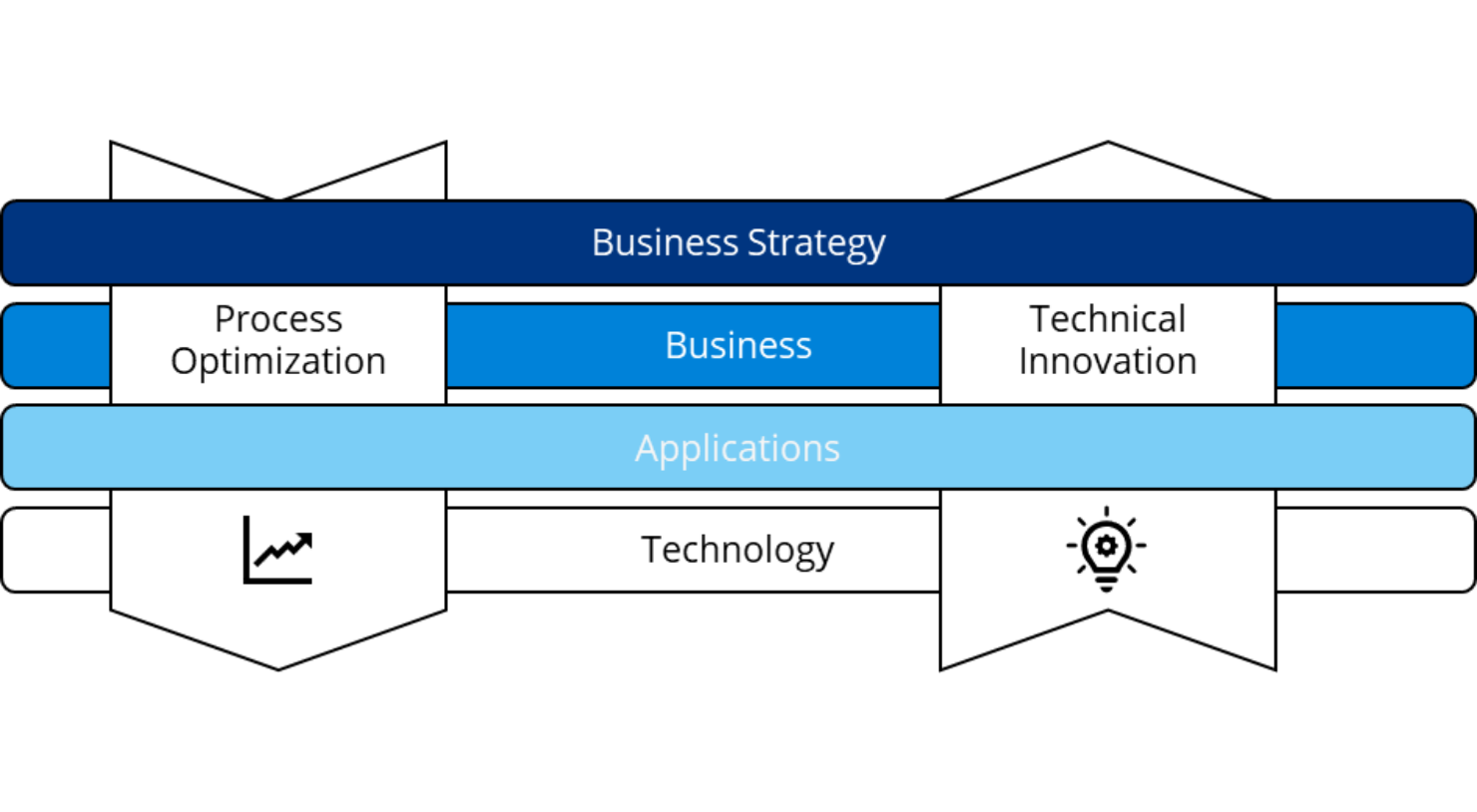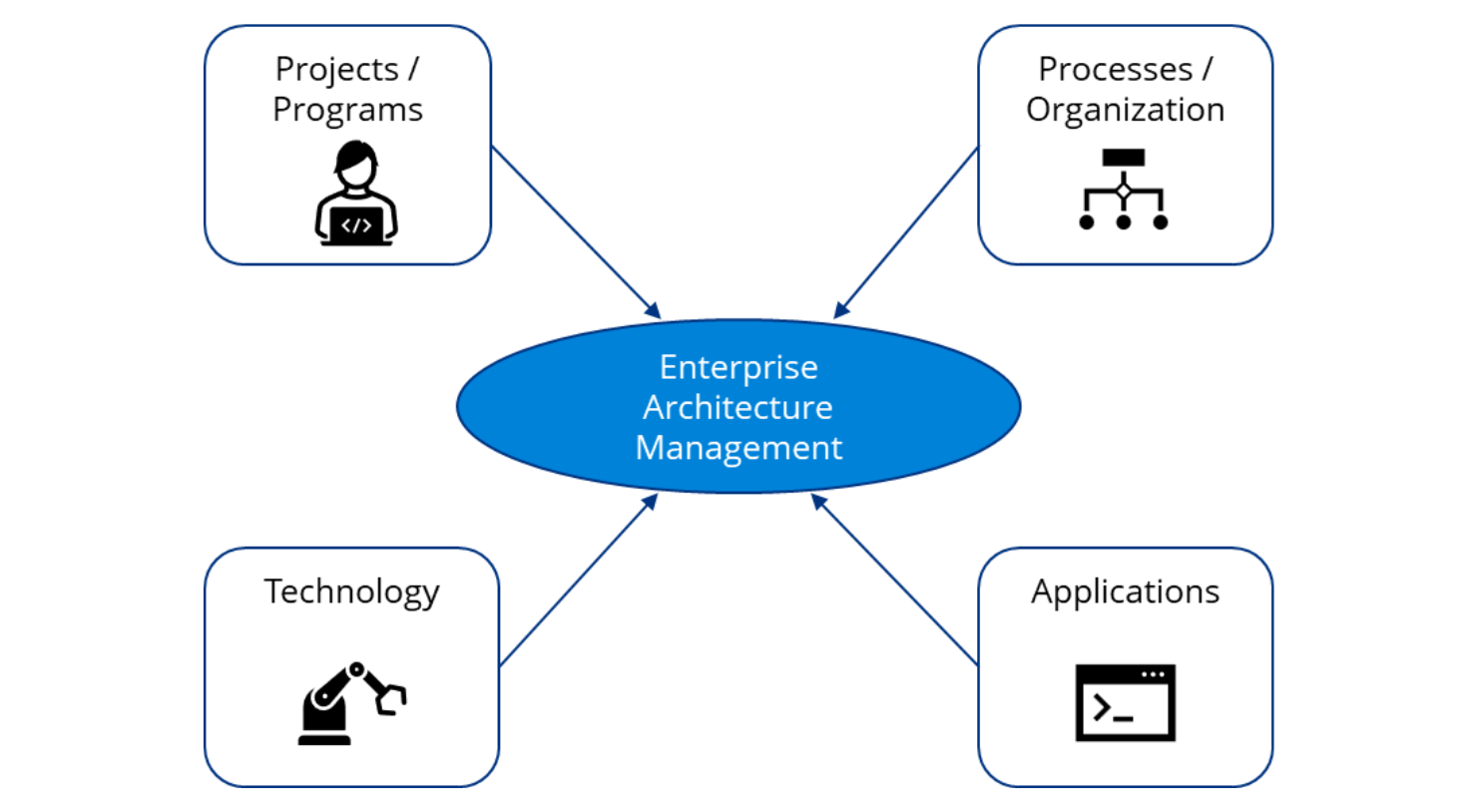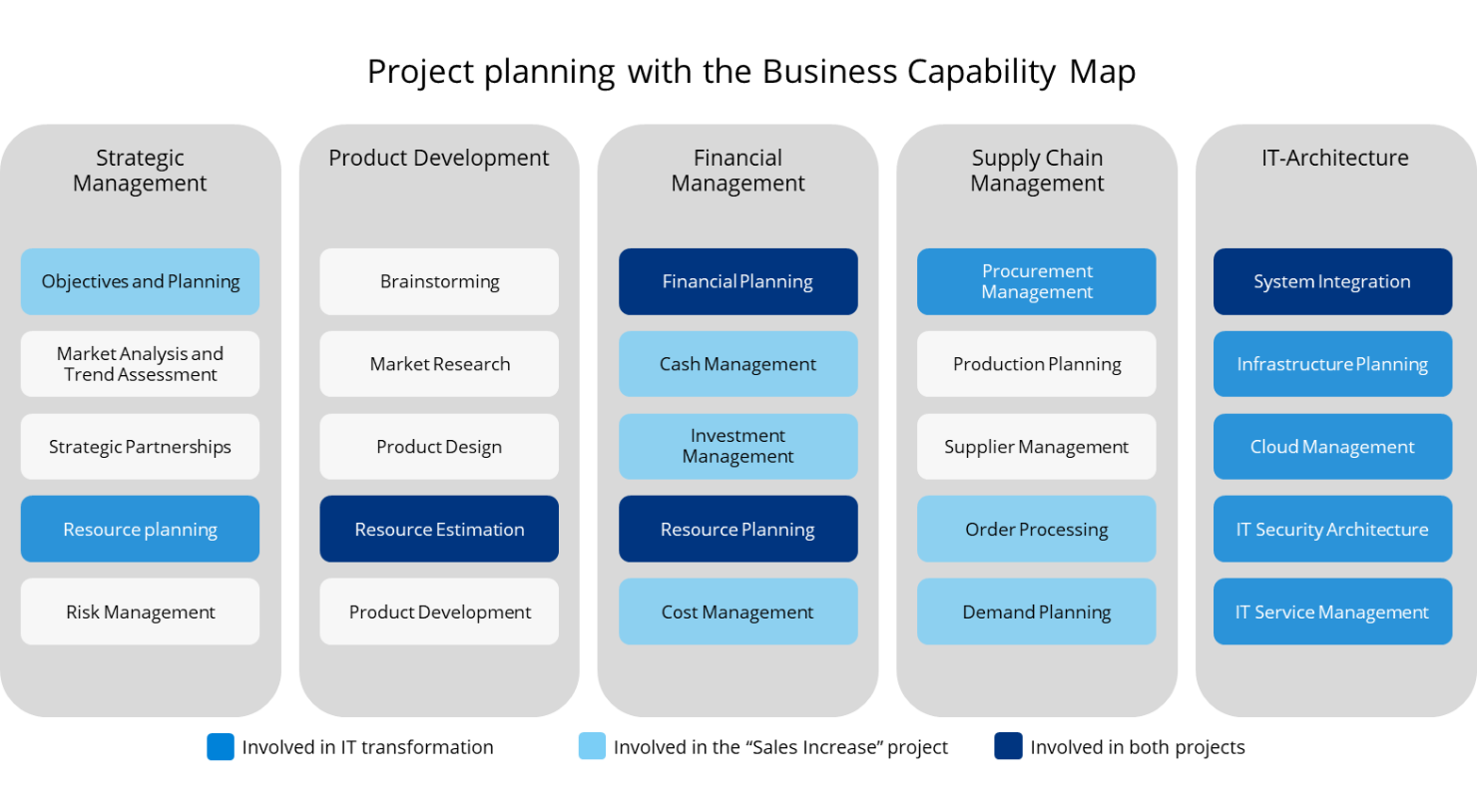
Enterprise Architecture Management (EAM)
Creating structures, securing the future
Global uncertainties, technological disruptions and intense competition pose enormous challenges for SMEs. Supply chains are more volatile than ever, skilled workers are in short supply and markets are changing in ever shorter cycles. Many SMEs are faced with a dual task: they have to keep existing structures stable while investing in new, digital business models and tapping into new sales potential.
Enterprise Architecture Management Is Not a Luxury, but a Real Competitive Advantage
There is often a lack of an integrating framework that links these challenges together, creates transparency and ensures that all activities contribute to the corporate strategy.
This framework needs to be found, because: Digital transformation and technological innovation open up enormous opportunities - for greater efficiency, new business models and a stronger competitive position. Those who adapt early will benefit from tangible advantages in the medium and long term. However, this requires a clear view of your own IT landscape: only those who know the strengths and weaknesses can develop and modernize it in a targeted manner and use it strategically for the company's success.
Here comes Enterprise Architecture Management (EAM) into play. For a long time, EAM was seen as a discipline for large corporations. But this view falls short. Medium-sized companies also have evolved IT landscapes, heterogeneous systems and a large number of parallel projects that need to be managed strategically. EAM is undergoing major change and is increasingly developing into a flexible management tool that offers SMEs in particular great added value.
Therefore: Enterprise Architecture Management is not a luxury, but a real competitive advantage - even in SMEs!
So What Exactly Is Enterprise Architecture Management?
Enterprise architecture management links business strategy, business, applications, and technologies to form a common basis for analysis. The aim is to create transparency, highlight connections and ensure that all components of the company contribute to the same strategic goals. This makes EAM a key tool for managing investments in a targeted manner, identifying risks at an early stage and coordinating change initiatives effectively. The connections are shown schematically in the diagram.

Business capabilities are an important tool here. They describe what a company does - i.e. its fundamental capabilities and value creation components - regardless of how or through which systems these are implemented. Business capabilities therefore form the bridge between business and IT: they help to translate strategies into specific fields of action, manage investments in a targeted manner and recognize the need for change in a structured way.
For SMEs, the decisive difference to large corporations lies in the pragmatism of the approach. SMEs need clear structures, comprehensible models and tools that deliver added value quickly. Many SMEs have long since laid the foundations for EAM. They document processes, manage applications or control projects strategically - all of these are already central elements of architecture management that can be developed further with structure and methodology. It is often less a question of creating something new than of making the existing visible, networking it and thus creating a common basis for strategic decisions. It is crucial to consciously combine these existing approaches and thus take the step from isolated activities to a genuine control logic.
In the following three use cases, we show how EAM can be used in SMEs:
Enterprise architecture management as a compass for strategic projects
Business capabilities as an integrator between strategy, business and IT
Enterprise Architecture Management as an enabler for transparency and control
EAM as a Compass for Strategic Projects
Digitalization projects, system modernizations, sustainability initiatives or the introduction of new products - medium-sized companies today are driving forward a large number of strategic projects in parallel. This harbors risks: The more transformation initiatives are running simultaneously, the greater the risk of duplication, dependencies or conflicting objectives. It is often challenging to maintain an overview.
-
How can Enterprise Architecture Management provide support here?

Enterprise Architecture Management can become a decisive management tool. By systematically linking projects with KPIs, processes and the IT landscape, a uniform picture of the situation is created - a genuine single source of truth. This creates transparency regarding dependencies and priorities, which enables targeted management of initiatives. But EAM is much more than just modeling structures: it is above all a communication tool that promotes dialogue between specialist departments, IT and management. With proven blueprints and clear communication mechanisms, strategic decisions can be made on a sound basis and collaboration across departmental boundaries can be sustainably improved.
-
What is an example from practice?
A medium-sized retailer is facing a classic challenge: three major transformation initiatives are running in parallel - the introductionleading a new ERP-Systems, the introduction of a CRM system and the digitalization of the service business. The project teams involved work largely independently of each other. There is no central view of dependencies, affected processes and data flows.
To solve this problem, an architecture-based project map is created as part of an EAM pilot project. Each project is linked to the affected business capabilities, processes and applications. From this, the company can quickly derive the first meaningful results:
ERP and CRM project use some of the same customer data
Both projects want to build interfaces to the service portal
The CRM project plays a key strategic role for the "After-Sales"
The result: cost savings through synergies, clear governance and focused management in line with the corporate strategy.
-
Key Takeaways
Enterprise Architecture Management serves as a strategic compass for the targeted management of a wide range of transformation initiatives. Linking projects with KPIs, processes and IT systems creates central transparency ("single source of truth"), which avoids duplication of work and conflicting objectives. EAM also promotes communication between IT, specialist departments and management.
Business Capabilities for Better Business-IT Alignment
One of the key success factors for companies is a shared understanding between specialist departments, IT and management. Where these perspectives come together, clarity, coordinated priorities and transparency regarding dependencies are created - the basis for effective and targeted implementation of change initiatives.
-
How can Enterprise Architecture Management provide support here?

Business capabilities are a central concept in enterprise architecture management (EAM). They describe what a company does - not how it does it. They therefore form a common language that is understood across departmental and IT boundaries.
Examples of such capabilities include purchasing, customer interaction or error forecasting. Business capabilities are usually structured hierarchically: Higher-level capabilities can be broken down into finer sub-capabilities, creating a structured view of the organization.
It is important to make a clear distinction here: a chatbot, for example, would not be a skill, but a technical solution that can support or improve a skill - in this case, customer interaction.
Through this neutral, technology-independent view, business capabilities create structure and clarity. They promote a common basis of understanding between business and IT without slipping into methodological complexity - and thus become the heart of a modern EAM approach. An example of the relevant capabilities can be found in the graphic above.
-
What is an example from practice?
A medium-sized mechanical engineering company is facing a clear challenge: the sales department is demanding the introduction of a customer portal through which dealers and end customers can order spare parts directly. The IT department should "simply build a portal" - but the actual goals remain unclear for the time being. There is the threat of a familiar communication pattern between business and IT: requirements are formulated as solutions without understanding the underlying "why".
As part of the EAM initiative the approach is changing. Instead of going straight into implementation, the enterprise architects ask specifically: "What Fcapability do you actually want to strengthen with this?" This discussion makes it clear: It's not about a portal per se, but about the ability to manage customer relationships efficiently - from ordering spare parts to after-sales support.
This shared view quickly yields concrete insights:
The portal strengthens customer self-service capability and relieves the burden on sales
Existing systems for product data and order processing must be integrated
New customer communication processes are required to handle queries efficiently
-
Key Takeaways
A common understanding between business departments, IT and management is crucial for the success of change initiatives - Enterprise Architecture Management supports this by creating a technology-independent, common language that enables clarity about goals, dependencies and relationships and thus translates technical requirements into business-oriented solutions, as the example of the mechanical engineering company shows, where the demand for a customer portal became a strategic project to strengthen customer relationship capability.
EAM for the Targeted Reduction of Application Costs
The IT expenditure of many companies is continuously increasing - new Cloud services, license models and departmental requirements ensurethat budgets are becoming increasingly difficult to understand. Companies often no longer know exactly what they are actually paying for: Which applications are actually being used? Where are there functional overlaps? And which systems cause high costs without delivering real added value? What initially sounds like a pure controlling issue is actually a question of transparency and structure in the IT landscape - and thus an ideal field of application ffor EAM.
-
How can Enterprise Architecture Management provide support here?

Enterprise Architecture Management provides the necessary overview of applications, costs, responsibilities and business relevance. With modern EAM tools such as BIC EAM or SAP LeanIX companies can capture, evaluate and visualize their entire application landscape.
This allows you to answer specific questions such as:
Which applications are actively used - and which are idle?
Where are there functional redundancies, i.e. several tools for the same target?
EAM combines technical, commercial and organizational perspectives for this purpose: The architectural view shows where applications are anchored, while cost data and usage information create transparency about efficiency and profitability. On this basis, management can make well-founded decisions - for example, which systems should be consolidated or decommissioned.
Modern platforms such as BIC or SAP LeanIX offerfor automated analyses and dashboards that make cost comparisons, usage patterns and redundancies visible -without increasing complexity. Analyses such as the application matrix above provide a quick overview of cost priorities and the use of duplicate applications. For example, the chart clearly shows that only Sales & Marketing uses Salesforce for its procurement management, while everyone else still relies on email programs.
-
What is an example from practice?
An international service company is facing a familiar problem: IT costs are rising, but no one can say exactly why. The management demands clarity - the IT department should "cut costs".
As part of the EAM initiative, the team begins to record the entire application landscape in the tool. Surprising findings quickly emerge:
Multiple departments independently use different tools for reporting and collaboration.
Licenses continue to run even though the corresponding systems are hardly used.
Costs for maintenance and operation of older on-premise applications are disproportionately high.
Through structured analysis, the EAM team identifies specific potential savings:
Merging three redundant tools into one central solution.
Discontinuation of obsolete applications with a low degree of utilization.
Negotiating better license models through clear usage data.
Within a few months, a consolidated, transparent IT landscape is created. The savings are measurable - and more importantly: IT and specialist departments gain joint control over their digital investments.
-
Key Takeaways
IT costs can only be managed sustainably if there is transparency about applications, usage and value contribution. Enterprise architecture management creates precisely this transparency by linking applications, costs and business objectives.
Modern tools such as BIC EAM or SAP LeanIX support companies in carrying out targeted analyses, avoiding duplicate structures and realizing potential savings - without creating additional complexity.
In short: If you don't just want to manage your IT, but actively shape it, you need EAM as a management tool - not Excel.
Conclusion
Enterprise architecture management is no longer a luxury for large corporations, but a decisive success factor for medium-sized companies. Anyone who understands their processes, systems and projects in context today can manage changes in a more targeted manner, prioritize investments better and make the digital transformation easier to plan.
The advantages for SMEs are obvious:
Transparency: EAM creates a clear overview of applications, processes, projects and responsibilities - and uncovers redundancies and risks at an early stage.
Strategic control: decisions are fact-based and comprehensible. Investments can be aligned with strategic goals instead of just operational requirements.
Efficiency: By linking business and IT, synergies are created, duplication of work is reduced and resources are deployed in a more targeted manner.
Future security: A clear architecture forms the basis for the long-term further development of technologies, systems and business models.
The important thing is: EAM does not have to start with a tool.
Many successful SMEs start with simple tools - such as a capability map, an application inventory or the linking of strategic projects with business processes. The decisive factor is the first step towards transparency, not the perfect model. Tools such as LeanIX or BIC EAM can support and professionalize this path later on, once the foundations have been laid.
As Arvato Systems, we accompany medium-sized companies precisely on this path - from the initial concept through the methodical introduction to the technical implementation of modern EAM platforms. Our strength lies in implementing EAM pragmatically, practically and at eye level - always with a focus on added value instead of complexity.
Get in touch with us - we'll be happy to accompany you on your journey!
Written by
